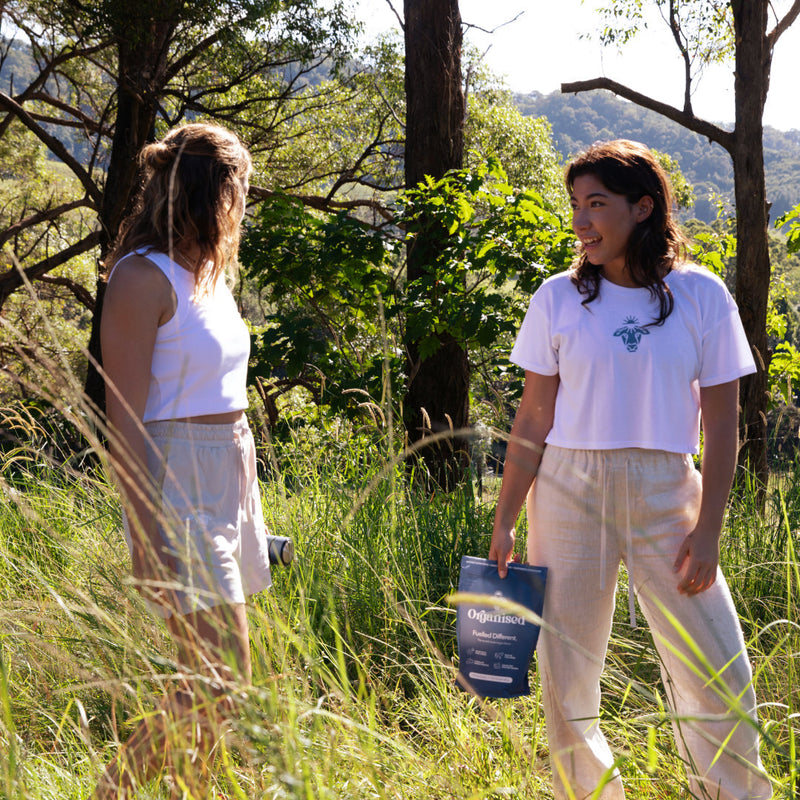
September 06, 2025
Why your immune system protocol isn't working (and what to do instead)
Most people treat winter like something gruelling to endure, accepting fatigue, frequent illness, and low energy as the norm, waiting for spring to come and fix everything. But winter was never meant to be survived in misery. Everything in nature is cyclical, and winter is just as important as summer when it comes to your health. It’s a season designed for nourishment, repair, and building the foundations of resilience from the inside out. But only if you know how to work with it. At the cusp of the changing seasons, this guide begins with what not to do, the common habits that leave most people depleted by February, and then shows you what to do instead. The issue with synthetic vitamin C Most people do this... Grab vitamin C tablets made from synthetic ascorbic acid at the first sign of a cold. While everyone reaches for vitamin C tablets at the first sign of a sniffle, your body craves the complete vitamin C complex found in whole food and your needs for this vital nutrient actually skyrocket during winter months. Here's why winter demands more vitamin C Cold weather creates significant oxidative stress as your body works harder to maintain core temperature. Indoor heating systems dry out your skin and mucous membranes, your first barriers against pathogens, requiring vitamin C for collagen production and tissue repair. Meanwhile, your adrenal glands, which produce stress hormones to help you adapt to seasonal changes and maintain energy, are among the most vitamin C-dense organs in your body. When they're working overtime during winter's shorter days and colder temperatures, they rapidly deplete your vitamin C stores. The difference? Synthetic ascorbic acid is just one component of the vitamin C complex. While being derived from GMO corn, ascorbic acid is doing more harm than good. Whole food sources provide cofactors that help your body actually absorb and use what you're giving it. Providing a more real and potent form of vitamin C from whole foods will always outperform ascorbic acid. Instead, do this... Acerola cherry and camu camu provide concentrated natural vitamin C, while seasonal kiwis and properly fermented sauerkraut offer this vital nutrient alongside beneficial bacteria that support your gut, your first line of immune defence. The vitamin D mistake everyone makes Most people do this... Take a vitamin D capsule to beat SAD and hope they’re covered. Synthetic vitamin D, especially when taken in isolation, doesn’t address the full picture. Your body doesn’t just need vitamin D. It needs the cofactors, light signals, and organ function to activate and integrate it. A pill can’t replace that. Instead, do this... Get natural light exposure morning, midday, and at dusk, even on cloudy days, this helps regulate circadian rhythms and supports vitamin D metabolism. Eat ancestral vitamin D-rich foods: wild-caught salmon, sardines, mackerel, and pasture-raised egg yolks. These offer a more bioavailable and complete form of vitamin D, alongside essential fat-soluble cofactors. Support the organs that activate vitamin D, your liver and kidneys, with bitter greens like dandelion and rocket, ensure you’re getting adequate magnesium, and stay well hydrated. Reaching for cold & flu tablets won’t fix it Most people do this... At the first sign of a stuffy nose or scratchy throat, they grab over-the-counter cold and flu tablets, chasing symptom relief instead of addressing the root cause. But your immune system isn’t asking for synthetic decongestants, it’s calling out for critical trace minerals that it relies on to function properly. And winter is the time when deficiencies in these nutrients become most apparent. Zinc directly supports white blood cell production while maintaining the integrity of your mucosal barriers. These barriers, from your nasal passages to your gut lining, are your first line of defence against pathogens. Oysters provide more bioavailable zinc than any supplement ever could, in a form your body can use instantly and effectively. Selenium works synergistically with iodine to support optimal thyroid function, which is crucial for maintaining your metabolic fire during winter. It also supports the production of glutathione peroxidase and selenoproteins that directly combat viral replication. Instead, do this... Reach for real, nutrient-dense foods that naturally contain these minerals in their most potent and absorbable forms: Oysters, liver & kidney for zinc Kidney & brazil nuts for selenium Grass-fed red meat for both, plus complete proteins and B vitamins that support overall energy and immune strength Why your diet needs to reflect the season Most people do this... Keep eating tropical fruits, smoothies, raw salads, or processed carbs, ignoring the body’s shifting seasonal needs. What to do instead... Cold weather drives up your thyroid and adrenal activity, increasing your need for warming, nutrient-dense foods rich in iodine, selenium, B vitamins, vitamin C, vitamin A, and zinc. Bone broths, stews, and slow-cooked foods provide easy-to-digest nutrients while warming the body from within. Root vegetables and squashes deliver steady energy, while warming spices like ginger and cinnamon support circulation and immunity. During winter, your body faces different conditions and challenges than it did in the summer. Seasonal eating isn’t just about eating with the seasons for the sake of it, it’s a biological truth. Your body’s needs shift with the seasons, and the foods nature provides at each point in the year are perfectly matched to those needs. Autumn is nature’s invitation to stock up. Root vegetables, squashes, apples, and late berries provide steady fuel, minerals, and antioxidants to prepare your immune system for the darker months ahead. This is also the time to ferment, preserve, and store food such as homemade jams that act as your nutrient insurance policy when fresh produce becomes scarce. Our ancestors understood this intuitively. They didn't eat the same foods year-round because their bodies didn't need the same things year-round. Summer's cooling foods like raw salads and tropical fruits would leave you depleted in winter, while winter's warming, slow-cooked stews and root veg will keep you thriving all winter long. Need some recipe ideas? We recommend our Venison Stew first. Why stopping movement backfires Most people do this... Stop movement altogether once the weather turns cold. One of the most overlooked aspects of winter wellness is the need to maintain movement and circulation when everything in nature seems to slow down. Stagnation is the enemy of vitality, and winter creates perfect conditions for both physical and energetic stagnation. When temperatures drop, most people naturally become more sedentary. This creates a cascade of problems: circulation slows, the lymphatic system becomes sluggish, and toxins that would normally be cleared through movement and sweating begin to accumulate. Your lymphatic system, a crucial component of immune function, only moves when you move. Even gentle daily movement like walking, stretching, or bodyweight exercises keeps this system flowing and your immune defences sharp. What to do instead... The goal isn't intense workouts that further stress your system during an already challenging season. Instead, think consistency over intensity. Consistent walks through the day, some light stretching, weightlifting, hiking or even just movement that’s enjoyable rather than torturing will serve you far better than sporadic high-intensity sessions. The lost art of sweating In summer, you naturally detox through your skin. Winter's bundled-up, sedentary lifestyle shuts down this crucial elimination pathway. Without regular sweating, your body struggles to release accumulated toxins, from environmental pollutants to metabolic waste products. What to do instead... This is where heat therapy becomes invaluable. Whether through sauna sessions, steam baths, or even hot baths with mineral salts, induced sweating mimics summer's natural cleansing processes. Regular sauna users consistently report fewer colds and respiratory infections and there's solid research backing this up. If you don't have access to a sauna, create heat at home. Hot baths with Epsom salts, followed by a cool rinse, can provide similar benefits while supporting mineral absorption through the skin. Why fresh air matters more in winter Most people do this... Stay inside for days at a time, then wonder why they feel foggy, anxious, or sick. While it's tempting to hibernate indoors all winter, this instinct works against your health. Indoor air during winter months becomes heavy with dust, mold spores, and chemical off-gassing from heating systems and reduced ventilation. This creates a burden on your respiratory system and immune function. Compare how you feel after spending a day outdoors in summer versus a day inside during winter. The difference isn't just about vitamin D, it's the quality of air you're breathing, the negative ions you're absorbing, as well as movement and the benefits of being out in nature. What to do instead... Getting outside daily provides measurable benefits: your lungs flush with fresh air, clearing indoor pollutants, natural light continues to regulate hormones even on cloudy days, cold air exposure boosts circulation and contact with natural environments restores electrical balance to your body. Sling a coat on and get out there! Daily practices such as grounding, direct skin contact with the earth (yes, even in winter), can massively help reduce inflammation in the body. Continuing to do this in winter is key. Stand barefoot if you're brave, but even touching a tree on a colder day has a similar effect. Protecting your immune defences overnight Most people do this... Stay up watching screens, overstimulated and disconnected from natural light cues, leading to poor sleep and hormonal imbalances. Winter's longer nights aren't just about enduring darkness, they're an invitation to optimise your most powerful restoration tool. The majority of deep physical repair happens between 10pm and 2am, when growth hormone peaks and your body directs energy into healing tissues, regulating the immune system, and detoxifying through the liver. Miss this window regularly, and your body misses its most potent opportunity to restore itself. Proper sleep during winter months sets the foundation for everything else: immune function, hormonal balance, mental clarity, and physical energy. What to do instead... Blocking blue light after sunset is key for circadian rhythm. Investing in blue light blocking glasses, beeswax candles and low to no blue light bulbs such as incandescent can all help you fall asleep quicker and gain a richer, deeper more restorative sleep. Even before sunset gets to its earliest, implement these from 7pm onwards! This supports your circadian rhythm and optimises hormones like melatonin and growth hormone that do their best work during quality sleep.













